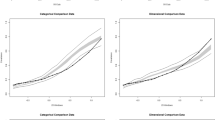Abstract
Recent studies of college women’s initiation of heterosexual contact have focused on the relationships among predictors of women's heterosexual initiating behaviors, initiating strategies, and theories concerning sexuality and indicate the importance of establishing the psychometric properties of the research measurements. The present study of 212 college women (mean age =22.3 years) investigated the factor structure underlying one of these tools, the Initiating Heterosexual Contact Scale (IHCS). The IHCS was developed to assess behaviors and motives relative to initiating heterosexual contact. subjects were administered a survey that included their self-report of initiating sexual contact with men. Factor analysis of the 26-item scale revealed a 19-item scale comprised of six factors—Sexual Arousal, Hidden Motives, Verbal Pressure, Retaliation or Gain, Physical Force, and Exploitation—accounting for 59.8% of the response variance. The internal reliability of the subscales ranged from .43 to .75. Recommendations for further refinement of the IHCS and areas of future research are suggested.
Similar content being viewed by others
References
Anderson, P., & Aymami, R. (1993). Reports of female initiation of sexual contact: Male and female differences.Archives of Sexual Behavior, 22, 335–343.
Byers, S. (1996). How well does the traditional sexual script explain sexual coercion? Review of a program of research.Journal of Psychology and Human Sexuality, 8, 7–25.
Craig, M. (1988). The sexually coercive college female: An investigation of attitudinal and affective characteristics. In C. L. Muehlenhard (Chair),Sexually coerced men and sexually coercive women. Symposium conducted at the annual meeting of the Society for the Scientific Study of Sex, San Francisco, Nov.
Gorsuch, R. (1983).Factor analysis. 2nd ed. Philadelphia: W. B. Saunders.
Hogben, M., Byrne, D., & Hamburger, M. (1996). Coeroive heterosexual sexuality in dating relationships of college students: Implications of differential male-female experiences.Journal of Psychology and Human Sexuality, 8, 69–78.
Kinsey, A., Pomeroy, W., & Martin, C. (1948).Sexual behavior in the human male. Philadelphia: W. B. Saunders.
Koss, M., & Gidycz, C. (1985). Sexual experiences survey: Reliability and validity.Journal of Consulting and Clinical Psychology, 53, 422–423.
Koss, M., & Oros, C. (1982). Sexual experiences survey: A research instrument investigating sexual aggression and victimization.Journal of Consulting and Clinical Psychology, 50, 455–457.
Muehlenhard, C., & Cook, S. (1988). Men's self-reports of unwanted sexual activity.Journal of Sex Research, 24, 58–72.
Nunnally, J. (1978).Psychometric Theory, 2nd ed. New York: McGraw-Hill.
O'Sullivan, L., & Byers, S. (1993). Eroding stereotypes: College women's attempts to influence reluctant male sexual partners.Journal of Sex Research, 30, 270–282.
O'Sullivan, L., & Byers, S. (1996). Gender differences in responses to discrepancies in desired level of sexual intimacy.Journal of Psychology and Human Sexuality, 8, 49–67.
Sarrel, P., & Masters, W. (1982). Sexual molestation of men by women.Archives of Sexual Behavior, 11, 117–131.
Stevens, S. (1992).Applied multivariate statistics for the social sciences. Hillsdale, NJ: Erlbaum.
Story, M. (1986).Factors affecting the incidence of partner abuse among university students. Unpublished manuscript. University of Northern Iowa, Waterloo, Home Economics Department.
Struckman-Johnson, C. (1988). Forced sex on dates: It happens to men too.Journal of Sex Research, 24, 234–241.
Struckman-Johnson, D., & Struckman-Johnson, C. (1996). College men's reactions to hypothetical forceful sexual advances from women.Journal of Psychology and Human Sexuality, 8, 93–105.
Author information
Authors and Affiliations
Rights and permissions
About this article
Cite this article
Anderson, P.B., Newton, M. The initiating heterosexual contact scale: A factor analysis. Sex Abuse 9, 179–186 (1997). https://doi.org/10.1007/BF02675063
Issue Date:
DOI: https://doi.org/10.1007/BF02675063



